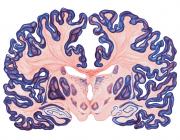Neurons with large bilateral receptive fields in monkey prelunate gyrus.
Publication Year
2001
Type
Journal Article
Abstract
In single-cell recordings from the dorsocaudal part of the prelunate gyrus of an alert monkey (Macaca fascicularis) we found neurons with unexpectedly large receptive fields (RFs) that spread bilaterally into the contra- and ipsilateral visual fields. These neurons (n=82) appeared to be clustered in the periphery of V4. They were surrounded by neurons with relatively small (3-10 degrees) and unilateral RFs in the contralateral field with properties similar to those previously described for neurons in area V4. Bilateral RFs extended over large parts of the lower visual field but always spared the fovea. Receptive fields typically revealed two foci of maximal responsiveness that were arranged symmetrically in the ipsi- and contralateral fields. Twenty-six cells did not respond to stimuli along the vertical meridian; these neurons had two distinct RFs. The preference for stimulus orientation, color, or motion was similar in all parts of these large RFs.
Keywords
Journal
Exp Brain Res
Volume
136
Pages
108-13
Date Published
01/2001
ISSN Number
0014-4819
Alternate Journal
Exp Brain Res
PMID
11204404

